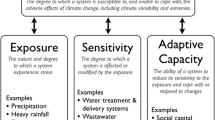Abstract
The relation between climate change and water-associated infectious diseases has become much more visible in recent times. Climatic changes are dealt with complex interactions among interconnected components of hydrological cycle such as atmosphere, biosphere, and geosphere. Extreme weather conditions such as storms may pollute the recreational coastal waters enhancing the risk of gastroenteritis and other water-associated infectious diseases. The contamination of drinking water is a prominent source of spreading water-associated infectious diseases during extreme water-related weather events. The water treatment plant system may get compromised due to heavy rainfalls insinuating infiltration of oocysts of cryptosporidium in drinking water reservoirs and remain persistent in water distribution system. Weather conditions influence the life cycle of arthropod vectors by affecting the survival rate, reproduction rates, habitat, abundance, and distribution; likewise it also affects the survival rate and proliferation rate of pathogen within the vector.
*Contributed equally as first author
Access this chapter
Tax calculation will be finalised at checkout
Purchases are for personal use only
Similar content being viewed by others
References
Semenza JC, Menne B (2009) Climate change and infectious diseases in Europe. Lancet Infect Dis 9(6):365–375
Lafferty KD (2009) The ecology of climate change and infectious diseases. Ecology 90:888–900
Karl TR, Trenberth KE (2003) Modern global climate change. Science 302:1719–1723
Dwight RH, Baker DB, Semenza JC, Olson BH (2004) Health effects associated with recreational water use: urban versus rural California. Am J Public Health 94:565–567
Frank C, Littman M, Alpers K, Hallauer J (2006) Vibrio vulnificus wound infections after contact with the Baltic Sea, Germany. Euro Surveill 11:E060817.1
Andersson Y, Ekdahl K (2006) Wound infections due to Vibrio cholerae in Sweden after swimming in the Baltic Sea, summer 2006. Euro Surveill 11:E060803.2
CDC (2015) Cryptosporidiosis surveillance—United States, 2011–2012. MMWR Suppl 64(3):15–25
Strathmann M, Horstkott M, Koch C, Gayer U, Wingender J (2016) The River Ruhr—an urban river under particular interest for recreational use and as a raw water source for drinking water: the collaborative research project “Safe Ruhr”—microbiological aspects. Int J Hyg Environ Health 219(7 Pt B):643–661
Cann KF, Thomas DR, Salmon RL, Wyn-Jones AP, Kay D (2013) Extreme water-related weather events and waterborne disease. Epidemiol Infect 141(4):671–686
Kistemann T, Classen T, Koch C et al (2002) Microbial load of drinking water reservoir tributaries during extreme rainfall and runoff. Appl Environ Microbiol 68:2188–2197
Lake IR, Bentham G, Kovats RS, Nichols GL (2005) Effects of weather and river flow on cryptosporidiosis. J Water Health 3:469–474
Wilby R, Hedger M, Orr HG (2005) Climate change impacts and adaptation: a science agenda for the Environment Agency of England and Wales. Weather 60:206–211
Senhorst HA, Zwolsman JJ (2005) Climate change and effects on water quality: a first impression. Water Sci Technol 51:53–59
Ashbolt NJ (2004) Microbial contamination of drinking water and disease outcomes in developing regions. Toxicology 198(1–3):229–238
Sorenson SB, Morssink C, Campos PA (2011) Safe access to safe water in low income countries: water fetching in current times. Soc Sci Med 72(9):1522–1526
White GF, Bradley DJ, White AU (2002) Drawers of water: domestic water use in East Africa. 1972. Bull World Health Organ 80(1):63–73
Mackenzie JS, Gubler DJ, Petersen LR (2004) Emerging flaviviruses: the spread and resurgence of Japanese encephalitis, West Nile and dengue viruses. Nat Med 10(12 Suppl):S98–S109
Hales S, de Wet N, Maindonald J, Woodward A (2002) Potential effect of population and climate changes on global distribution of dengue fever: an empirical model. Lancet 360(9336):830–834
Lambrechts L, Scott TW, Gubler DJ (2010) Consequences of the expanding global distribution of Aedes albopictus for dengue virus transmission. PLoS Negl Trop Dis 4(5):e646
Frumkin H, Hess J, Luber G, Malilay J, McGeehin M (2008) Climate change: the public health response. Am J Public Health 98:435–445
Semenza JC, Giesecke J (2008) Intervening to reduce inequalities in infections in Europe. Am J Public Health 98:787–792
Greenough G, McGeehin M, Bernard SM, Trtanj J, Riad J, Engelberg D (2001) The potential impacts of climate variability and change on health impacts of extreme weather events in the United States. Environ Health Perspect 109(Suppl 2):191–198
Lignon BL (2006) Infectious diseases that pose specific challenges after natural disasters: a review. Semin Pediatr Infect Dis 17:36–45
Garzoni C, Emonet S, Legout L, Benedict R, Hoffmeyer P, Bernard L, Garbino J (2005) Atypical infections in tsunami survivors. Emerg Infect Dis 11(10):1591–1593
Centers for Disease Control and Prevention (CDC) (2005) Infectious disease and dermatologic conditions in evacuees and rescue workers after Hurricane Katrina—multiple states, August–September, 2005. MMWR Morb Mortal Wkly Rep 54(38):961–964
Author information
Authors and Affiliations
Corresponding author
Editor information
Editors and Affiliations
Rights and permissions
Copyright information
© 2020 Springer Nature Singapore Pte Ltd.
About this chapter
Cite this chapter
Haikerwal, A., Saxena, S.K. (2020). Impact of Climate Change on Water-Associated Infectious Diseases. In: Saxena, S.K. (eds) Water-Associated Infectious Diseases. Springer, Singapore. https://doi.org/10.1007/978-981-13-9197-2_6
Download citation
DOI: https://doi.org/10.1007/978-981-13-9197-2_6
Published:
Publisher Name: Springer, Singapore
Print ISBN: 978-981-13-9196-5
Online ISBN: 978-981-13-9197-2
eBook Packages: MedicineMedicine (R0)




